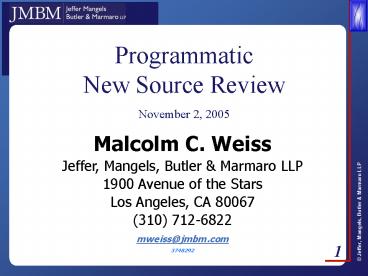Programmatic New Source Review - PowerPoint PPT Presentation
1 / 18
Title:
Programmatic New Source Review
Description:
Permits required to construct new or modified major stationary sources ... Demonstrate that all major sources under common ownership/control comply ... – PowerPoint PPT presentation
Number of Views:45
Avg rating:3.0/5.0
Title: Programmatic New Source Review
1
ProgrammaticNew Source Review
- November 2, 2005
Malcolm C. Weiss Jeffer, Mangels, Butler
Marmaro LLP 1900 Avenue of the Stars Los Angeles,
CA 80067 (310) 712-6822 mweiss_at_jmbm.com 3748292
2
Responsible Agencies
- Federal U.S. Environmental Protection Agency
(implements CAA, sets goals, national policies
and regulatory framework) - State California Air Resources Board (mobile
sources, coordinate with local/federal agencies,
state standards, SIP) - Local Air Quality Management Districts (SCAQMD)
(stationary sources, permitting, prohibitory
rules, compliance, AQMP, MRR)
3
Clean Air Laws Overview
- 1970 Fed. Clean Air Act Adopted
- 1977 Major Amendment to CAA
- 1988 California CAA
- 1990 Major New Amendments
4
1970 Clean Air Act
- First major federal air legislation
- U.S. EPA created (ARB created in 1967)
- Earth Day - April 22, 1970
5
1970 Clean Air Act (cont.)
- Authority delegated to states
- Establishes National Ambient Air Quality
Standards (NAAQS) - State Implementation Plans required
- Begins national permit programs
- New Source Review (NSR)
- States to meet NAAQS by 1975
6
1977 CAA Amendments
- Gives states more time to meet NAAQS
- Expands NSR
- Applicable to new sources
- Major modifications at existing facilities
- Review of NAAQS by 1980
- Attainment and Nonattainment areas
7
1977 CAA Amendments (cont.)
- Basic Applicable Requirements
- Prevention of Significant Deterioration of Air
Quality (Part C) (PSD) - Plan Requirements for Nonattainment areas (Part
D) (NSR)
8
1990 CAA Amendments Overview
- Title I - Attain and maintain NAAQS
- Title II - Mobile sources
- Title III - Hazardous air pollutants
- Title IV - Control acid rain
- Title V - National uniform permit system
- Title VI - Stratospheric ozone protection
- Title VII - Enforcement
9
1990 CAA Amendments
- Classifies ozone nonattainment areas marginal,
moderate, serious, severe, and extreme - Classifications trigger stringency of
requirements - Extends attainment dates for extreme areas
10
CaliforniaThen and Now
- 1970
- California's population is 20 million
- More than 12 million vehicles
- VMT is 110 billion miles
- 2000
- California's population is 34 million
- More than 23 million vehicles
- VMT is 280 billion miles
11
Motor Vehicle Impacts
- Up to 50 of NOx and VOC (smog)
- gt 50 of hazardous air pollutants
- 90 CO in urban areas
12
Air Quality Management Plan
- SCAQMD
- Air Quality Analysis
- Overall Planning
- Stationary Sources
- SCAG
- Transportation
- Growth Management
- Land Use
- ARB
- Mobile sources
- Vehicle standards/ fuel
- Consumer products
- Strategies
- All known control technologies
- Technology forcing and incentives
- Major technology breakthroughs
13
Part D of Title I Federal NSR
- Permits required to construct new or modified
major stationary sources - NSR and the permitting process are linked
- Expanded opportunity for public comments
14
Federal NSR (cont.)
- New Sources - NSR is triggered only if the
emissions make it a major source - Existing Sources - NSR is triggered if the
modification significantly increases emissions
15
Federal NSR (cont.)
- Permits to Construct/Operate require that major
stationary sources - Install equipment to meet the Lowest Achievable
Emission Rate (LAER) - Obtain offsets (ratios)
- Demonstrate that all major sources under common
ownership/control comply
16
NSR Reform
- Reform was urged because of the growing
indication that current regulations hinder,
rather than promote improvements in air quality - SCAQMD has filed a lawsuit contesting the reforms
17
NSR Reform
- Routine Equipment Replacement Rule (10/27/03).
Equipment replacement is excluded from NSR if - It replaces an existing process unit
- with functionally equivalent components
- the cost of the replaced is lt 20 of the
replacement value of the entire process unit - the basic design of the equipment does not
change and - emissions limits not exceeded.
18
ProgrammaticNew Source Review
- November 2, 2005
Malcolm C. Weiss Jeffer, Mangels, Butler
Marmaro LLP 1900 Avenue of the Stars Los Angeles,
CA 80067 (310) 712-6822 mweiss_at_jmbm.com 3748292































